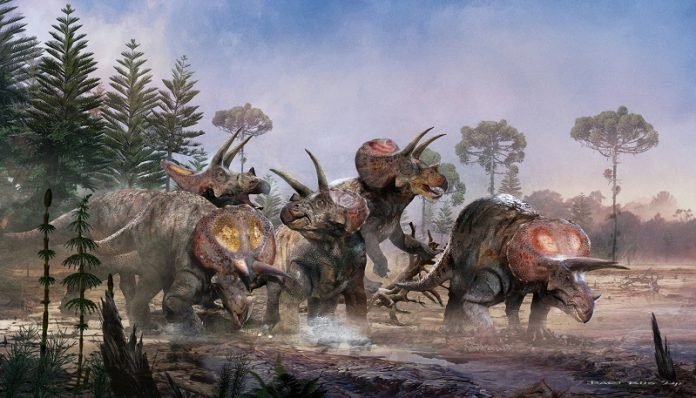
In the summer of 2013, a team from the Naturalis Biodiversity Center in the Netherlands went on a dinosaur hunt in Wyoming, hoping to find a Tyrannosaurus rex.
But instead of finding the king of dinosaurs, they stumbled upon a different treasure: not one, but five Triceratops buried together.
Triceratops are those cool dinosaurs with three horns on their faces and a big shield-like frill around their necks.
This discovery was unexpected and exciting, leading to a massive project that lasted over ten years.
The team, including both professionals and volunteers, worked hard to carefully dig up 1,200 bones and fragments from at least five different Triceratops.
A researcher named De Rooij was brought on board to solve a prehistoric mystery for his Ph.D.: How did these dinosaurs end up dying together?
What could their bones tell us about their lives and how they met their end?
Thanks to the excellent condition of the bones, De Rooij could figure out quite a bit about these ancient creatures. For instance, he discovered that Triceratops grew very slowly.
His research suggests that these five dinosaurs died at the same time, possibly stuck in a swamp, and were buried in a single layer of rock, with no other types of animals mixed in.
By studying the hundreds of teeth from these dinosaurs, De Rooij also concluded that they might have migrated together. This means they likely had some form of social behavior, sticking together as they moved from place to place.
This discovery opens up a lot of new questions, like how complex their social behavior was. Were these Triceratops friends?
Did they travel in groups like some animals do today?
The head of the project, Prof. Anne Schulp, and the entire team are thrilled with the outcome. Thanks to their work, the Naturalis museum now boasts the largest collection of Triceratops fossils in the world.
And De Rooij has become the first person in the Netherlands to earn a Ph.D. with a thesis on Triceratops, earning him the nickname “Dr. Triceratops.”
The findings from this incredible discovery didn’t just fill up research papers; they’re also being shared with the public through an exhibition at the Naturalis museum. Starting in October, visitors can learn about these five Triceratops and see how they lived—and died—together 67 million years ago.
The exhibition is not just staying in the Netherlands; it’s set to travel the world, bringing the story of these ancient creatures to people everywhere.



